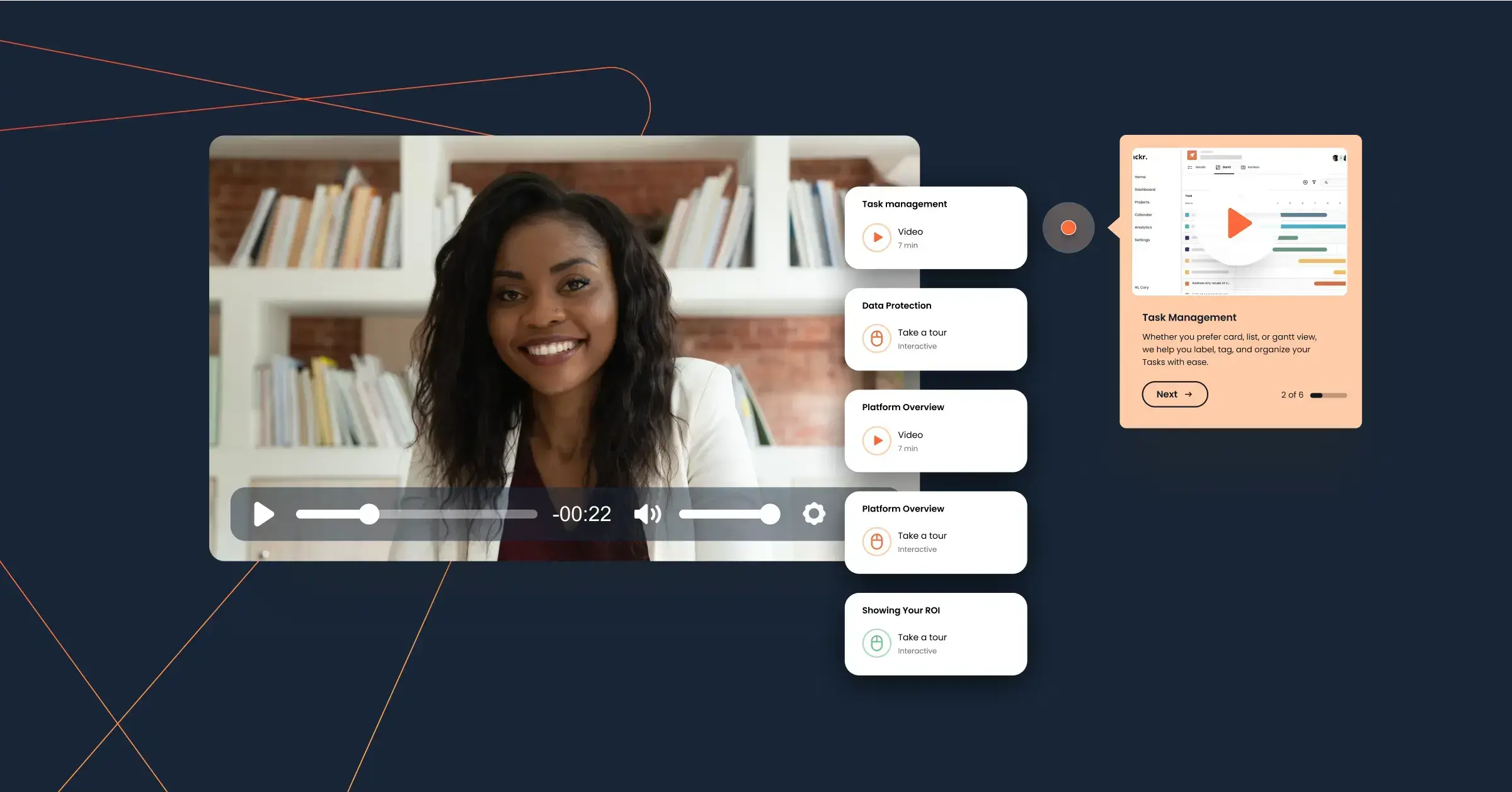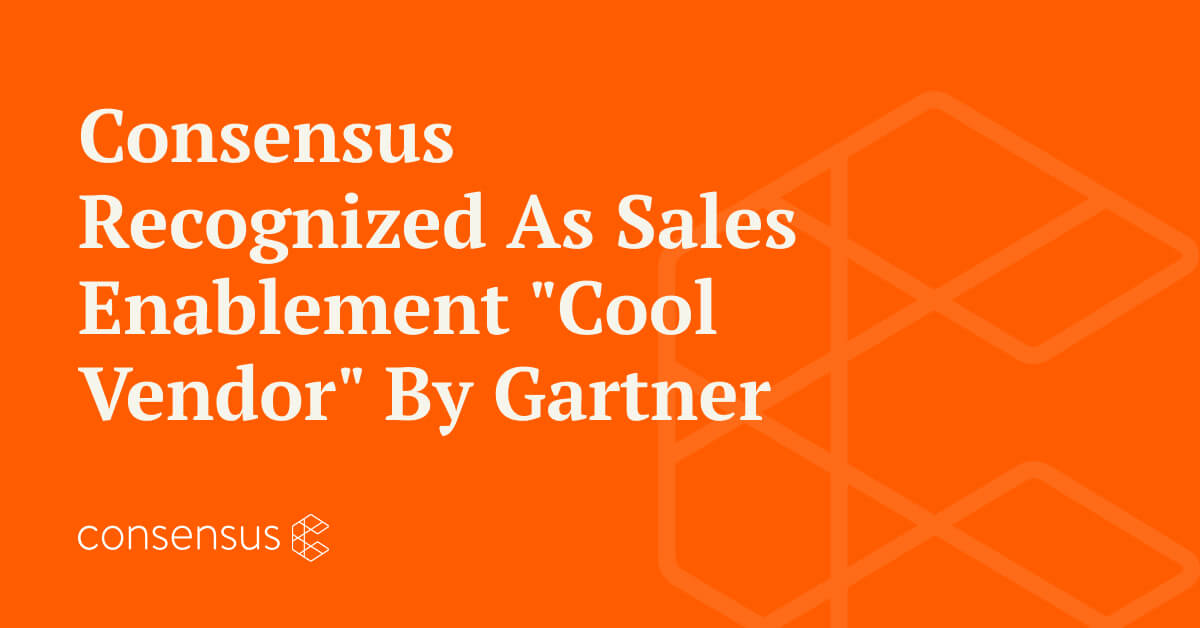Close more deals with
Demo Automation.
Watch a Demo
Lengthy sales cycles are bad for everyone.
Modern customers get frustrated when they have to bend over backward to get the information they need to make the right decision. Sales reps feel defeated when they reach out to a customer only to find out they’re sticking to their old system or, worse, get no response. And both parties get tired of conflicting calendars making it difficult to schedule discovery calls and stretching out the entire process.
Maintaining deal momentum and finding ways to shorten sales cycles is essential to avoid these issues. But more than half of companies are seeing longer sales cycles, with cycle durations expanding by over 50%. How do we reverse these trends? Let’s explore practical, high-impact ways to shorten your sales cycle and strengthen buyer relationships.
Build smarter sales motions so your team sells faster with our B2B Buyer Behavior Report.
What is the Sales Cycle?
The sales cycle is the collection of steps the sales and presales teams take in order to close new deals and sign new customers. It begins with research, moves through stages like qualifying and nurturing leads, and ends by overcoming objections and closing the deal.
Depending on your product and your unique sales process, your organization might average sales cycles that last just a few weeks—or some that last for years. For example, a retail store might have a sales cycle that only lasts minutes, while the average sales cycle for a B2B organization lastslands at around 100 days long and SaaS companies see sales cycles at an average of 84 days long.
Teams strive to shorten sales cycles to stay efficient, quickly bring on new clients, and bring value to buyers ASAP.
What Is Considered a Short Sales Cycle?
For lower-cost products or services with straightforward buying processes, sales cycles might last as little as a few hours to a few weeks. Deals with an annual contract value under $2,000, for example, usually close within 14 days. That’s because these types of sales don’t need layers of approval or deep technical reviews—buyers can make decisions confidently and move forward faster.
What Is a Long Sales Cycle?
A long sales cycle is one that stretches over months, even years, especially for high-value or enterprise-level deals. These sales often involve complex products, multiple stakeholders, and detailed technical, legal, and financial evaluations that take time to navigate.
For example, B2B deals worth around $100,000 usually take three to six months to close. And as more stakeholders get involved, the process slows even more, adding extra layers of review and approval before a final decision is made.
Sales Cycle vs. Sales Funnel vs. Sales Process
The terms sales cycle, sales funnel, and sales process all describe a similar timeframe in the customer lifecycle, yet their definitions and uses differ in purpose and focus.
The sales cycle describes the time it takes for a new lead to turn into a closed sale. Why do we care? By improving an organization’s sales cycle, you can close more deals at faster rates, ultimately bringing in more revenue. There’s generally an emphasis on timing and duration in conversations about the sales cycle.
The sales process is your organization’s workflow within the sales cycle. The process is built of the repeatable actions your marketing, presales, and sales teams follow with every lead—your replicable building blocks, if you will. With those tried and true blocks, you can create a strategic sales process and a consistent progression from leads to customers.
Finally, the sales funnel functions as a visual representation of the customer journey. The top, largest section of the funnel represents the leads who might click on an ad or find your product via search engines or social media. As leads move through the funnel, some drop off at each stage, creating that familiar narrowing shape. For example, some might click your ad but decide not to sign up for your email list.
Leads who continue to complete further steps of your sales process (such as interacting with demos or booking discovery calls) make it to the bottom, thinnest section of the funnel. That’s where they engage in sales calls, learn more about your offer, and eventually (ideally) convert.
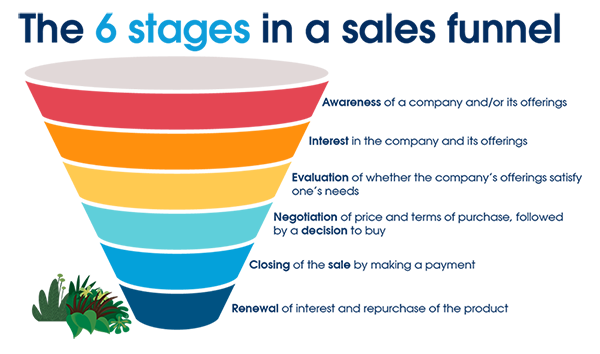
Sales Cycle Stages
Knowing how the sales cycle works is the first step to shortening it and closing more deals. Here’s how it works:
Conducting Research
The first step in the sales cycle is to carry out thorough research to get to know your target buyers. When you can anticipate objections, pain points, needs, and vocabulary of your ideal customers, you’re more likely to nurture leads effectively and close deals more consistently.
Depending on your niche, conducting research might involve joining social media groups to read through the common questions and discussions, making online searches about topics your key customers might dig into, hosting focus groups to hear from them directly, or attending networking events to pick up on trending subjects. The research phase never really ends, since you’ll continue to learn about your buyers through the rest of the sales cycle (and beyond!).
Prospecting
Once you have a solid understanding of your target customers, it’s time to find them. Prospecting is the process of finding potential buyers. This can take place through a variety of channels and tools, and each business type and niche has its own ideal prospecting strategies.
Through databases, online searches, and even social media, sales teams can develop a healthy list of new leads who might benefit from their product.
Qualifying Leads
Before you move into later phases that might require hands-on attention and follow-up, make sure you’re investing time in a lead that can truly benefit from your solution. A qualified lead needs your solution, the budget to afford it, and the authority within their organization to invest in it.
Depending on your unique offer, determine the other qualifications your leads need to meet, like appropriate capacity on their team, schedule alignment, and ideal integrations.
Nurturing
After qualifying a lead as a great fit for your solution, the next step is to guide them in learning about your product. While there are many ways to nurture leads—like free trials or follow-up calls—one of the most effective (and scalable) approaches is using AI-powered interactive demos.
With platforms like Consensus, you can deliver self-guided, on-demand demos that adapt in real time to each buyer’s role, industry, and priorities. It’s a powerful way to combine personalized engagement with automation—without requiring live resources from your sales or presales teams. And with the help of Consensus AI, creating and scaling these demos is faster and easier than ever.
This means stronger buyer enablement, easier internal sharing, and faster sales cycles—leading to 2X more deals closed and a 30% acceleration in pipeline velocity. AI-powered demos make it effortless to nurture leads with relevant, tailored content at every stage of the journey.
Sending Proposals
Now that your buyer has seen firsthand how valuable your product can be, seize the moment and send them your proposal. A proposal outlines the details of a potential partnership, including:
- Your pricing tiers with details on what each tier includes
- Your suggested solution based on what you’ve learned about your buyer
- A detailed implementation plan
- An overview of your support and maintenance process
- A problem statement that clearly outlines the pain points your product will solve
With a proposal in hand, your buyer should have a thorough understanding of the exact value you offer and how much your solution will cost them.
Overcoming Objections
While some buyers will be ready to sign on as soon as they’ve experienced a demo and viewed the proposal, others may need to talk through their concerns, questions, and objections before making a final decision.
Your initial research can help guide you in handling those objections in a way that resonates with your buyer. The goal is to address your buyer’s concerns by illustrating how your product is the best solution for them and the right investment to help them reach their goals.
Closing The Deal
You did it! With all objections tackled, it’s time to go in for the close. No deal is complete until contracts have been signed and payments are made. If there are additional questions you need to answer or negotiations that need to take place, address these steps quickly so that you can complete the deal and move out of the sales cycle and into onboarding.
How to Shorten Sales Cycle and Close Deals Faster
Shortening your sales cycle means adding efficiency to your sales team, paving the way for more closed deals and a higher volume of new customers. Here’s how you can close deals faster:
1. Use AI-Powered Interactive Demo Software
According to our Sales Engineering Compensation and Workload report, roughly 35% of demos are unqualified or underqualified. As a result, sales engineers waste valuable time—anywhere from 2-10 hours per demo—on live buyer interactions that don’t contribute meaningfully to closing deals.
While intro demos play a role in early buyer education, they don’t need to happen live. At this stage, buyers are looking for a high-level overview to determine if your solution is even worth exploring further. Instead of tying up presales resources in repetitive calls, AI-powered interactive demos let you deliver personalized, self-guided experiences that buyers can engage with anytime.
Platforms like Consensus make this easy. With AI-driven features like dynamic content prioritization, voiceover generation, and automated responses to buyer questions, teams can create and scale demos that feel tailored—without the manual effort. For example, Consensus AI adapts demos based on the buyer’s role, pain points, and intent, surfacing the most relevant content first to capture attention and accelerate qualification.
And it’s not just for early-stage leads. Even deeper in the funnel, SEs can use AI to build demos that address specific objections, highlight advanced features, and guide stakeholder groups—freeing up time for more strategic, high-impact conversations.
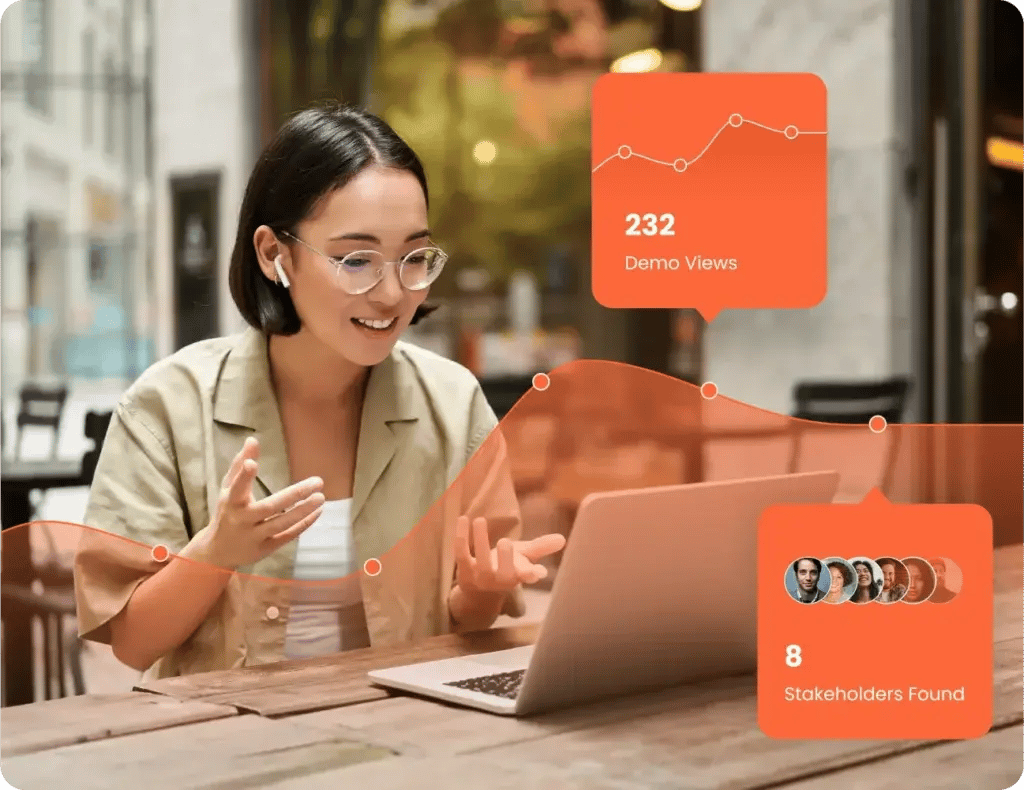
To make sure you’re getting the full benefits of using demo automation, use these best practices:
- Ask customers to watch a digital demo before every meeting and encourage them to share the demo with everyone attending
- Follow up during the days leading up to the meeting to remind them to view it
- Thank them for viewing the digital demo after they watch it and start a conversation via email about what they thought
- For lower-value leads, you can take a stricter approach and require that the digital demo be viewed before the meeting with phrases like, “Would you mind watching this short demo before we connect? If now’s not the right time, I’m happy to reschedule when it works better for you.”
Learn more tips–like what time and day to send your content and the ideal length of content–in this year’s B2B Buyer Behavior Report.
How can interactive product demonstrations help sell complex software?
Interactive demos make complex software easier to sell by turning it into something buyers can actually use: a hands-on, sandbox-style environment where they can click through real workflows, test key features, and experience the product’s value firsthand. This “show, don’t tell” approach helps demystify technical capabilities and builds confidence across both business and technical audiences.
Using a demo automation platform like Consensus, teams can quickly create automated product simulations that replicate live environments without heavy setup. These simulations help sales engineers address technical questions faster, demonstrate use cases in context, and scale the hands-on experience to every stakeholder—no live instance or manual configuration required.
2. Eliminate Demo Lag Time
Demo lag time refers to the period between when a customer submits their information on your site and when they actually receive a demo. It sounds like it should be a simple process—fill out a form and get a demo within a day or two—but in reality, demo requests are rarely that straightforward.
Buyers now wait an average of six to ten business days just to get a demo—and that delay adds up. According to Gartner, demo lag accounts for roughly 25% of the total time it takes a buyer to make a purchasing decision.
Simply removing the wait time for buyers to see a demo can dramatically shorten sales cycles. Automated demos allow buyers to fill out a form and instantly access a tailored demo experience, reducing lag time by as much as 89%.
How can you deliver instant product simulations for software buyers?
The best way to deliver instant product simulations for software buyers is to use a platform that lets you build interactive, customized experiences in minutes—no complex setup or coding required.
With Consensus, you can create personalized product simulations almost instantly that feel like a real product sandbox–but require a fraction of the setup. Powered by AI, Consensus automatically adapts each simulation to a buyer’s role, industry, and priorities, making every experience as relevant as it is immersive.
These simulations are easy to pair with a live demo: show the core experience during the call, then leave behind a guided version buyers can explore later. It’s a faster, lower-effort way to give stakeholders hands-on validation and keep momentum going after the meeting.

3. Improve Prospect Qualification & Engagement
Live demos will never disappear. They definitely have a time and place—but have you ever had a meeting that could have been an automated demo? Adding automated demos to your channel sales strategy gives your leads the chance to experiment with your solution firsthand and self-educate using your interactive content.
At the same time, automated demos give you the chance to reduce unqualified live demos by analyzing how buyers engage with them and comparing that data directly to your ideal customer profile (ICP).
When a buyer watches an automated demo, the system tracks exactly how they interact: what features they explore, how long they engage, which videos they replay, and whether they share the demo internally. This engagement data gives you a clear picture of buyer intent and fit before a sales rep ever gets involved.
From there, you can compare these insights against your ICP benchmarks—things like company size, industry, use case, tech stack, and buying authority. For instance, if your ICP focuses on enterprise SaaS companies that care most about integrations and scalability, a buyer who spends most of their demo time on those modules (and shares the demo with multiple technical stakeholders) fits the profile perfectly. That buyer becomes a demo qualified lead (DQL) and should move forward to a live demo.
On the other hand, if someone barely interacts, skips key product areas, or doesn’t fit your ICP firmographics, you can disqualify or route them into a nurture sequence instead. This data-driven approach ensures your team only invests live demo time in high-intent, high-fit opportunities, improving efficiency, boosting close rates, and keeping your sales cycle lean.
4. Implement AI and Automation
Not every stage of the sales cycle needs hands-on effort from your sales team. With the right AI and automation tools, you can eliminate repetitive tasks, keep buyers engaged, and give your reps more time to focus on high-value conversations.
AI sales tools make it easy to:
- Send perfectly timed, on-brand messages through automated email sequences
- Share consistent product information across teams with automated demos
- Trigger timely follow-ups based on buyer actions and engagement data
- Create personalized outreach that adapts tone, timing, and content with the help of AI
Consensus AI can help your team deliver more relevant product experiences like these with far less manual effort. Turn ideas into polished videos, tours, and simulations in minutes, not days. AI-generated storyboards, voiceovers, video production, and scalable simulation editing streamline content creation and eliminate friction from the process.
How can demo automation software reduce friction in the buying process?
Demo automation software removes unnecessary roadblocks from the buying experience by giving buyers immediate, on-demand access to your product. Not only do these demos align perfectly with whatever stage your buyer is currently in, but because they’re automated, they can be sent in between meetings, keeping deal momentum high.
They’re also shareable so that internal champions can send them to other buying group members. This keeps your message consistent and helps surface additional stakeholders earlier in the process. And the more your demos are viewed, the more likely you are to close. Our B2B Buyer Behavior Report shows that buyers who engage with nine or more demos have a close rate above 55%, an 8–10x increase compared to those who never watch one.
Once you see that engagement spike, Consensus AI steps in to help turn that momentum into a closed deal. It analyzes which stakeholders are watching, what they’re most interested in, and where engagement drops off. Then it recommends the right next move—whether that’s looping in the decision-maker, scheduling a live demo to go deeper, or sending follow-up content that addresses key priorities. The result is a buyer journey that feels effortless, informed, and tailored from start to finish.
5. Leverage Urgency
Creating a sense of urgency is one of the most effective ways to shorten sales cycles—but urgency doesn’t have to mean high pressure. It can also mean keeping momentum strong and helping buyers make confident, timely decisions.
Start by tightening your follow-up cadence. When interest is high, don’t let days slip by before the next touchpoint. Automate reminders, nurture emails, and demo follow-ups so buyers always know the next step, and time those messages to go out on high-engagement days. Our report shows that Tuesdays through Thursdays drive the highest demo and content engagement. Activity also spikes at specific times of day, typically when buyers are between meetings or clearing out their inboxes.
Use your platform’s behavioral data to schedule your outreach when attention is at its peak. Don’t be afraid to create gentle urgency, either—set clear decision timelines, like confirming by a specific date to secure onboarding time, lock in limited pricing, or stay aligned with an upcoming project milestone.
You can also create urgency by showing what’s at stake if they delay, whether it’s lost efficiency, continued costs, or a competitive disadvantage. Frame it around impact, not pressure. For example: “If we get started this month, your team could see results by Q2,” rather than, “You need to sign now.”
And keep friction low. Make it easy for buyers to say yes by simplifying the proposal process, streamlining approvals, and ensuring decision-makers have everything they need early on. The goal isn’t to rush them so much as keep the deal moving while their motivation is at its peak.
6. Track Conversions Between Sales Cycle Stages
Keeping close track of relevant conversion data helps sales teams understand where buyers are falling off or where there are bottlenecks. The overall goal? Move as many qualified leads to close as possible.
Work toward that goal by tracking conversions for:
- Requesting an automated demo
- Viewing a self-led demo
- Interacting with a virtual tour
- Sharing the demo with additional stakeholders
- Booking a call with a sales representative
Test different messaging and sales approaches and track the impact of each variation on your conversions. That way, you can keep optimizing your sales cycle stages and maximizing win rates.
Consensus’ Demolytics makes tracking conversion data effortless, offering actionable insights across six levels—from high-level performance metrics to detailed heat maps and feature-level engagement dashboards.
For example, you can see which stakeholder groups viewed the demo, which features they clicked on, who shared it internally, and what the average view time was. The data syncs right into your CRM or other business tools, making it easy to fine-tune your messaging, adjust demo formats, and plan smart follow-ups that keep your win rates climbing.
7. Ensure Team Alignment
There are few things more frustrating than nearing the end of the sales cycle with an excited buyer, only to realize they’re not the actual decision-maker at your target company. Early in the nurture stage, confirm who on your buyer’s team is responsible for the final decision and what budget is available for a new solution. If necessary, offer to bring additional stakeholders into the conversation to keep everyone aligned from the start.
A helpful hint for seeing if you’ve reached key decision-makers? Use Consensus to check if your buyer shared their self-service demo with the rest of their team. When your first point of contact experiences your demo and sees the value in your solution, they can easily spread the word. This allows internal decision-makers to explore it firsthand without the hassle of scheduling multiple meetings to loop everyone in.
8. Deal with Objections Early
Completing in-depth customer research allows you to anticipate key concerns and holdups your buyers may have before investing. That means you can address these concerns proactively—without them needing to ask. Make your buyers feel like you’re reading their mind by busting each objection in advance through your value-based selling approach.
And when tough questions do come up, address them head-on. Work through any concerns with authentic conversations that prioritize their needs and pain points.
9. Personalize the Sales Cycle
No two buyers are exactly alike—each has different communication preferences, priorities, and pain points. Personalizing the sales cycle can increase marketing ROI by 10–30% and lift revenue by 5–15%, per McKinsey.
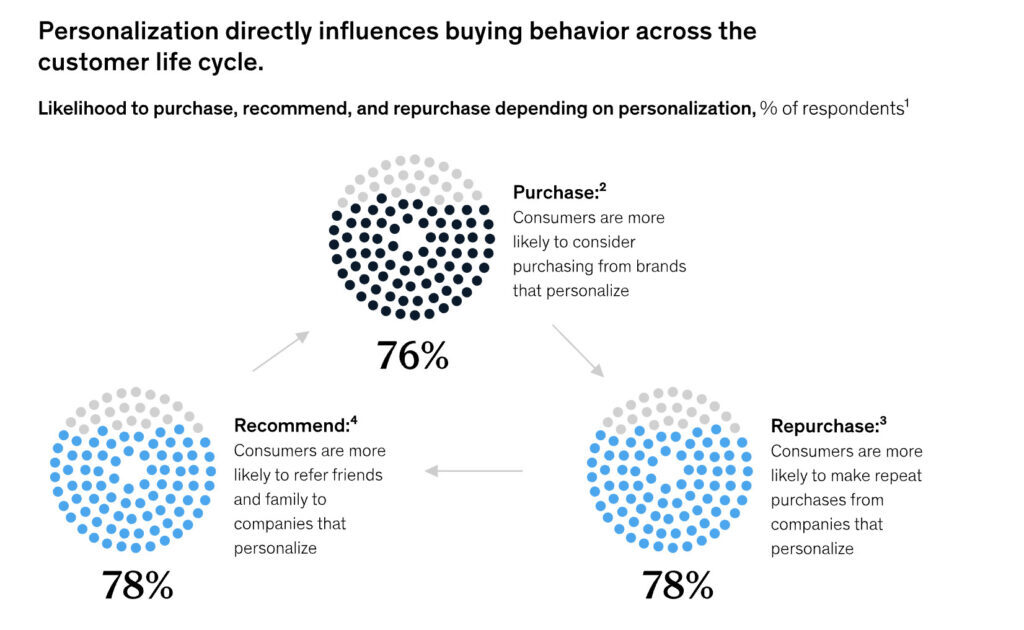
Use tailored messaging, relevant case studies, and demos that speak directly to each buyer’s top needs. Some examples of personalization in the sales process include:
- Emails sent at a specific cadence with unique content according to the buyer’s priorities
- Personalized videos
- Demos tailored to the buyer’s top needs
- Adjusted follow-up cadence according to each buyer’s communication style and schedule
- Relevant social proof and case studies pertaining to their specific industry
Tools like Consensus let you configure demos that ask buyers about their priorities upfront, then automatically generate a customized product tour highlighting the features most relevant to them. Buyers get a clear, contextual view of your product’s value, while your sales team saves valuable time otherwise spent on repetitive walkthroughs.
10. Make It Easy to Sign the Deal
Ride the momentum of a high-quality demo and a solutions-focused sales call with streamlined onboarding. Too many steps or a complicated signing process can introduce new doubts and slow down the close.
Here's how to keep things moving?
- Outline the exact actions each party needs to take to finalize the deal and guide your buyer through each step
- Keep contracts simple and transparent—no hidden fees or complex legal jargon
- Use digital contracts and a trusted payment platform to keep signing fast and secure
A straightforward closing process not only leads to more closed deals but sets the stage for positive, long-term customer relationships.
Shorten Your Sales Cycles with Demo Automation
No one wants a sales cycle that drags on—it’s frustrating for both sellers and buyers. Using a demo automation platform is one of the most effective ways to shorten sales cycles and improve team productivity. It gives your revenue team the agility to create and share personalized video demos or product tours instantly. Buyers get the information they need when they need it, while sellers cut down on repetitive tasks and keep deals moving, even between meetings.
With Consensus, you don’t just automate demos—you scale personalized, interactive experiences that show you exactly how buyers are engaging. No more guessing which deals are gaining traction. You’ll see who’s watching, what content they’re most interested in, how demos are being shared across stakeholder groups, and where buying intent is heating up.
That kind of visibility transforms how your team prioritizes and engages. Instead of chasing cold leads or wasting cycles on unqualified buyers, sales and presales teams can focus on high-potential opportunities, keep momentum high, and show up to every conversation with real context.
Consensus combines AI-driven personalization with deep buyer insights to move deals forward faster. Whether it’s automatically surfacing the most relevant demo content for each stakeholder or revealing what’s resonating across the account, Consensus creates a smoother, smarter, and more impactful path to purchase—at scale.
Explore Consensus to see how AI and demo automation can revolutionize your sales process—and start closing deals faster today.
FAQs on How to Shorten Your Sales Cycle
What are the benefits of demo automation in B2B sales?
Demo automation makes the B2B sales process faster, smoother, and more efficient. Instead of scheduling a live demo for every buyer, sales teams can share interactive, personalized demos at scale. This shortens sales cycles, reduces repetitive tasks, and saves hours of manual work for both sales and pre-sales teams.
Consensus makes demo automation effortless from start to finish. Teams can quickly build professional-quality demos, customize them for different audiences, and update content in minutes, all without heavy design or engineering support. Everything stays consistent, on-brand, and easy to deliver across every stage of the sales process.
The platform’s AI demo assistant builds on that efficiency with auto-generated storyboards, realistic voice-oversvoice overs, and data-backed recommendations that help teams produce effective demos in minutes, not hours. The result is a friction-free buyer journey that sparks interest, aligns stakeholders, and turns buyers into your biggest champions.
What is the 2 2 2 rule in sales?
The 2 2 2 rule is a simple follow-up strategy that helps you stay on your buyer’s radar without being pushy. It involves reaching out 2 days after a meeting or demo to thank them and answer questions, checking in again 2 weeks later to keep the conversation going, and reconnecting 2 months later to offer support or discuss next steps. The goal is to maintain consistent, genuine engagement that builds trust and moves the deal closer to a close.
What is the 70/30 rule in sales?
In sales, the 70/30 rule means spending 70% of your time listening to buyers and 30% talking. It encourages sales reps to spend most of the conversation learning about the buyer—asking questions, uncovering pain points, and understanding their goals—rather than focusing the conversation too much on the product.
When reps listen more than they speak, they build stronger connections and tailor their solutions more effectively. It’s a simple approach that shifts the focus from pitching to helping, which often leads to better results.
How can product tours accelerate the sales cycle?
Product tours accelerate the sales cycle by giving buyers instant, self-guided access to your product’s features and benefits. When buyers can explore on their own, they gain a clearer understanding of the value you offer—and in many cases, sell themselves on your product before the first sales call even happens. This creates higher-intent leads for the sales team, freeing them to focus on closing deals instead of explaining basic features.
With Consensus, you can create interactive product tours in minutes, complete with live UI elements, clickable hotspots, and branching paths that adapt to each buyer’s interests. These tours can be shared anywhere and automatically updated as your product evolves, making them one of the most scalable ways to engage and convert modern B2B buyers.
What is the 10 3 1 rule in sales?
The 10 3 1 rule is a sales formula that highlights the effort typically required to close a deal. It suggests that for every 10 buyers you contact, around 3 will become qualified leads and 1 will convert into a sale. It’s a practical reminder of the importance of consistency and volume in sales outreach.
How do interactive demos aid in B2B software sales?
Interactive demos make B2B software sales more engaging and efficient by putting buyers in control of their own experience. Instead of waiting for a scheduled walkthrough, they can dive right in to explore the features that matter most and see firsthand how your software solves their challenges.
And as buyers navigate the demo, your team gains visibility into their interests: what they clicked, how long they engaged, and which features drew the most attention. That insight turns every follow-up into a focused, value-driven conversation rather than a generic pitch.
Demo automation platforms like Consensus take this a step further by using AI to automate personalization and track engagement across all stakeholders, helping sales teams scale tailored experiences that drive faster, more informed decisions.
How can on-demand demos help overcome complex buying cycles?
On-demand demos remove the slow, manual steps that make complex buying cycles drag on like scheduling multiple one-off demos for different teams or spending hours customizing slide decks for each buyer.
Instead, teams can send interactive demos that explain value, address objections, and showcase relevant features automatically. Each stakeholder gets the info that matters to their role—finance sees ROI, IT sees integrations, end users see workflows—so internal alignment happens faster and with less hand-holding from sales.
Consensus makes this possible with automated demo personalization, analytics that reveal who’s engaging and how, and sharing tools that let buyers circulate demos internally to build consensus without slowing the deal down.
.

